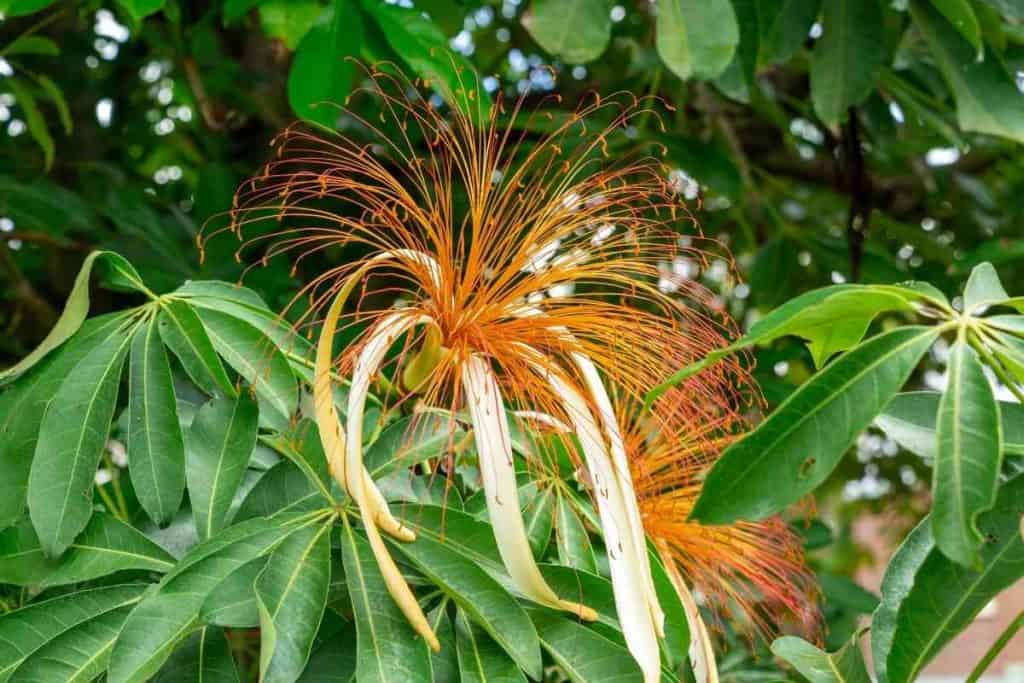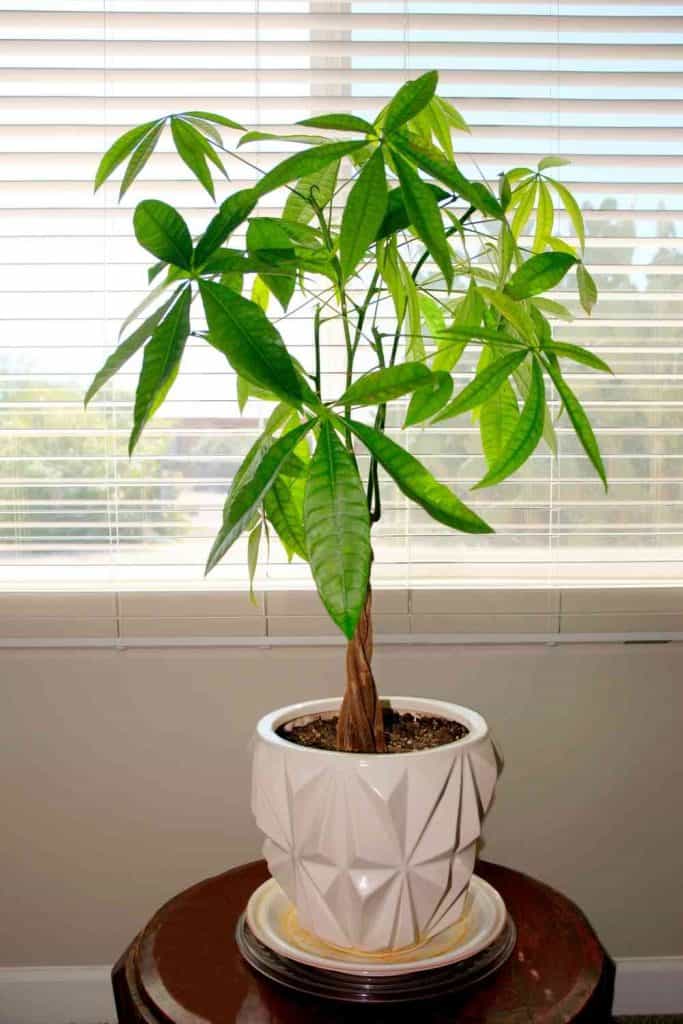The money tree is an easy maintenance plant but requires adequate attention and care. Therefore, negligence or failure to tend to it may result in severe predicament and problems. Once you notice some strange conditions in your plant, it is essential to figure out the problem.
It could be that the money tree is dying, which is one of the significant problems that come with the plant. But can a dying money tree be revived?
The simple answer is YES, and this article will show you how to revive a dying money tree! If you want to save a dying money tree, you must recreate conditions like high humidity, steady moist soil, and indirect sunlight, to enable it to recuperate.
More details on that later!
Table of Contents
What Is a Money Tree?

A tropical wetland tree from the mallow family 'Malvaceae,' the money tree plant originated from Central and South American swampy areas. Scientifically called Pachira Aquatica, the money tree features a braided trunk and lush, glossy leaves, making it a popular plant.
So many people believe that the plant brings fortune, affluence, and vitality to its home. But one thing we are sure about the money tree is the unique touch it adds to your home or office. It is a broadleaf evergreen plant that can grow up to 60 feet tall, while its braided variety can grow from 1 to 8 feet tall.
Its other names include Good Luck Tree, Malabar chestnut, Guiana Chestnut, French Peanut, Saba Nut, Monguba, Pump, Provision Tree, and Wild Kapok Tree.
And ever since it was first planted as a modern money tree in Taiwan during the 1980s, it has quickly established itself as a symbol of affluence and is highly sought after by Feng Shui practitioners.
Today, the money tree is cultivated in different varieties, such as Mini Money Trees, giant Money Trees, and multiple Money Trees planted together in one pot called Money Tree Forest. The plant is easy to care for, but neglect can cause them to die off.
How To Revive Dying Money Tree
Before we delve into how to revive a dying money tree, it's important to understand why your money tree is dying in the first place and how you can prevent them.
So, permit us to digress a little as we give you a brief highlight of some of the reasons for a dying money tree, which will help you determine ways of preventing them.
In each of these problems, we will also highlight the various symptoms that will tell you that your money tree is suffering from it, followed by how to save it from such problem.
Let's get started!
Why Your Money Tree Is Dying (How to Revive It)

1. Root Rot
Root rot is a defect in plants caused by excessive watering. Another cause of root rot is when you use rich soil mix or have an inadequate drainage system.
As a result, the roots will remain wet for more than usual and become weak, giving ways to any diseases and pests that will destroy the plant.
Symptoms of Root Rot include:
- Bad smell from the soil
- Brown and black spots on leaves
- Droopy and dull leaves
- Slow growth
How to save money tree from root rot:
If you want to revive a dying money tree that is suffering from root rot, you must report the plant through the following steps:
- Remove the plant carefully from its pot
- Inspect the situation of the roots to know the severity of the root rot
- Carefully use water to rinse the roots to make them clean
- Trim the rotted roots with a sterilized pair of scissors or pruning shears
- Position the roots under the sun to dry them a bit
- Also, prune the rotten leaves and stems
- Get a fresh pot and fill it with a well-draining soil mix halfway before carefully placing your plant inside. Ensure you apply soil from all areas to fill up all holes
- Position the plant where they could get bright indirect sunlight and don't overwater again
- You can fertilize the plant in a few days
Preventive Measures:
If you want to prevent your money tree from suffering root rot, you must know how much and when to water it. Significantly, the money tree needs frequent watering once in one or two weeks; therefore, begin by watering once a week and see what happens.
But the vital thing is to water it only when the soil is dry. Watering without checking the soil might result in overwatering; hence, root rot. Also, keep your plant in a sunny location with good airflow to enable the soil to dry up on time and prevent it from staying wet for an extended period.
2. Pest Infestation
You will hardly see a pest because it is a tiny insect that feeds on your plant's sap and eats up every available nutrition, thus causing the plant to grow weak and vulnerable. The most common pests that feast on money trees include spider mites, aphids, mealybugs, gnats, etc.
Symptoms of Pest Infestation include:
- White spots on leaves
- Leaves develop holes
- Fall off of fresh leaves
- Slow growth
- Speckled leaves
How to revive guiana chestnut from pest infestation:
- Separate the money tree from other plants to avoid spreading the disease to other plants around them.
- Sprinkle it over the money tree with an excellent organic miticide such as a neem oil solution to kill the pests.
- Rubbing alcohol can also do the trick when you dip a cotton ball in it and touch it on the infected parts of the plant.
- Commercial pesticides can solve it, but make sure they don't contain harmful chemicals.
Preventive Measures:
Avoid a damp environment, as they attract pests. Again, insufficient light, especially during the winter, can take the plant longer than expected to dry.
Find a bright area that attracts indirect sunlight to position your plant to avoid pests. Again, don't overwater or over-fertilize, and sprinkle them with neem oil solution every month to scare off pests.
3. Overwatering
As we earlier mentioned, overwatering can result in root rot. However, it can also result in other issues.
Symptoms of overwatering include:
- Leaves turn yellow
- Leaves turn brown
- Fresh leaves fall off
- Pests hover around the plant
Failure to address these symptoms will cause root rot
How to save the plant:
- Stop watering as soon as possible
- Place the plant under a bright area to enable it to dry out and get proper airflow
- Water as soon as the soil is dry
- Inspect the moisture level using a moisture meter before you water
Preventive Measures:
- Make sure you check the soil always to see its dryness before watering the money tree.
- Using your finger, check the level of moisture in the soil
- Make sure it has suitable drainage holes and they are not blocked.
- Make sure the draining system doesn't retain excess water.
Note: The money tree needs little watering during the winter and more during the summer.
4. Underwatering
Failure to water your plant as often as it requires will cause your plant to be under-watered, thus resulting in several problems and sudden death.
Even though the money tree can tolerate under-watering for specific periods, because it likes infrequent watering, over-stretching for extended periods will result in many problems for the plant.
Symptoms of underwatering include:
- Dry and crisp leaves
- Leaves turn brown
- Stunted growth
- Dull foliage
- Leaves start drooping
How to revive the plant:
- First, you must trim all damaged leaves that have changed color and become crisp
- Give the plant thorough watering
- Immediately it recovers, stop neglecting it and endeavor to give it the proper watering it needs to stay healthy
Preventive Measures:
- Thorough and sufficient watering prevents the money tree from dying. Also, ensure the excess water is getting grained via the drainage holes.
- Ensure the soil is appropriately draining; however, ensure it retains its needed moisture.
- Ensure you inspect the soil's moisture before watering rather than blindly following the watering routine.
5. Inappropriate Cultural Conditions

The money tree thrives under high humidity levels and high temperatures in its tropical areas. Failure to replicate these conditions at home or garden will result in numerous problems, including damaging the plant. Instead, you can place it in a controlled environment with high humidity and temperature levels.
Unsteady temperature and humidity levels might occur in the winter season, thus disturbing your plant. And failure to address the problem on time, all efforts to revive the plant might prove abortive.
Symptoms of Inappropriate Cultural Conditions include:
- Leaves develop brown spots
- Plant becomes stressed
- Leaves changes color
- Drooping of fresh leaves
- Shrinking of leaves
How to save the plant:
- First, you must get rid of the damaged leaves via pruning
- Ensure humidity levels stays at 50% and temperature around 65 to 80 degrees Fahrenheit
- If necessary, increase the humidity with a humidifier
Preventive Measures:
- Avoid exposing the money tree to cold temperatures in the frost season
- Keep the plant in the kitchen or bathroom in an area that attracts more humidity in the winter season.
- Avoid placing the plant very close to the furnace or any fireplace that will burn the plant
- Ensure you maintain its perfect temperature and humidity and avoid making any sudden alterations so the plant won't be stressed
By maintaining these conditions, you are taking preventive measures to prevent your money tree from dying in the first place.
6. Lighting Problems
Low light and direct sunlight are both terrible omens to the health of your money tree. So, it would be best if you avoided any of these conditions.
The money tree needs indirect light for about 6 to 8 hours each day. Hence, excessive direct sunlight or insufficient light for an extended period can damage the plant.
Symptoms of Lighting Problems include:
For low light, you will notice:
- Droopy leaves
- Leggy growth
- Weak stems and leaves
For direct sunlight, you will notice:
- Wilting leaves
- Leaves turning brown
Possible Remedies:
- Re-position the money tree in an area that receives enough indirect light for at least six hours each day.
- Place the plant close to a window and monitor how it receives direct sun. If it is, shift the plant a bit from the window.
- You can give it direct sunlight in the morning and late evening hours.
Preventive Measures:
- Do not place your money tree under direct sunlight to avoid a sunburnt situation.
- If it is outside, make sure it is under a shade to protect it.
- If it doesn't receive enough light, you can substitute the natural sunlight conditions with artificial light.




